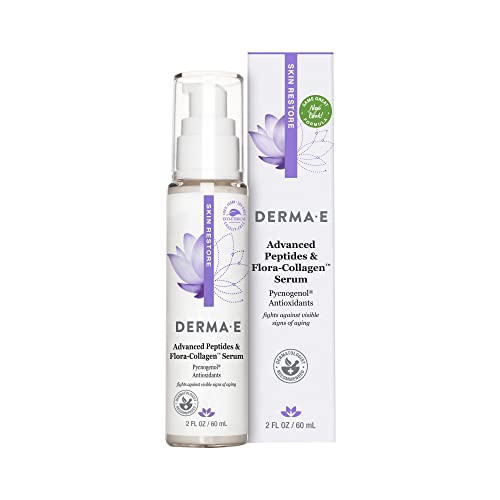
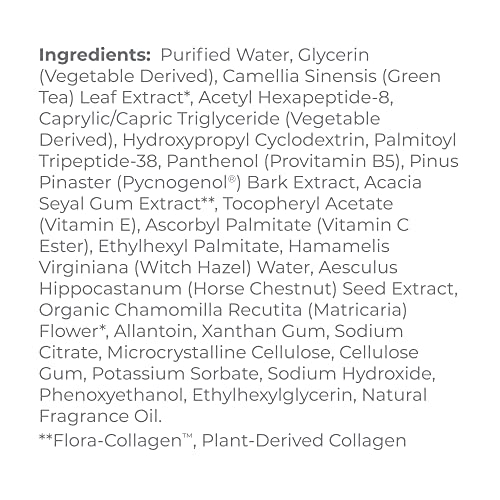
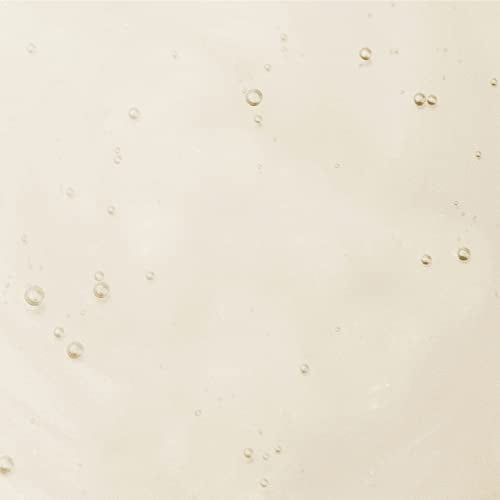
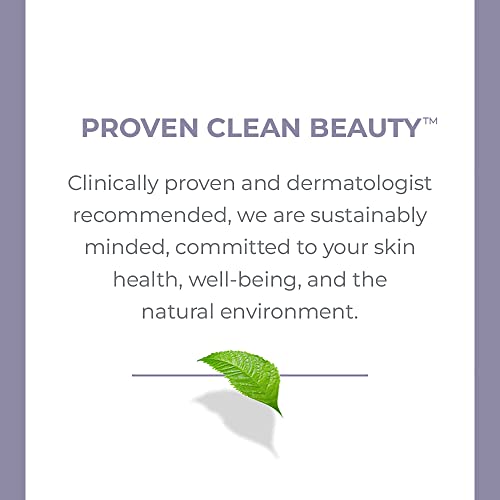
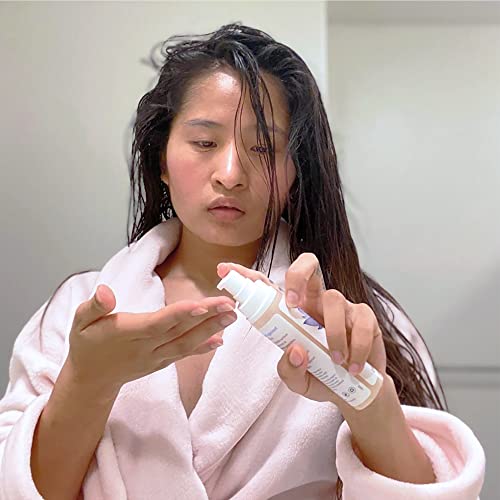
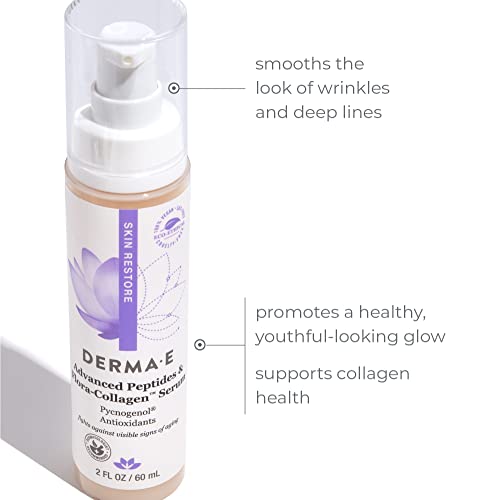
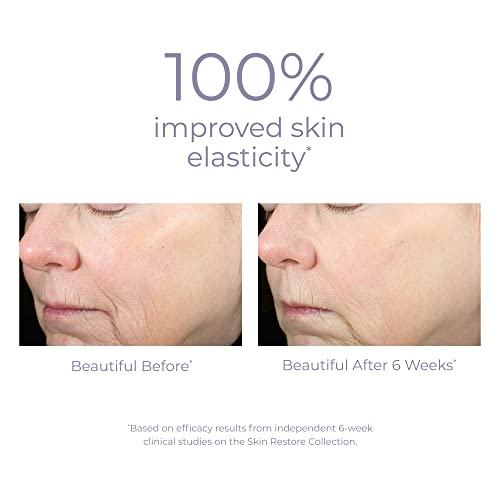
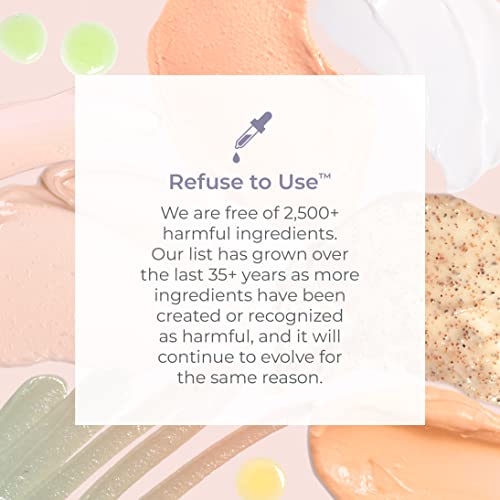
DERMA E Face Serum - Hydrating Peptides & Plant Collagen for Youthful Skin - 2 oz


Chamomilla Recutita (Matricaria) Flower
High RiskChamomilla recutita (Matricaria) flower, commonly known as chamomile, is a botanical ingredient used primarily for its soothing properties in cosmetic formulations. It is often included in products designed for sensitive skin due to its potential calming effects.
Sustai Insights
Chamomilla recutita offers functional benefits such as skin soothing and anti-inflammatory properties, which can be advantageous in formulations for sensitive skin. However, it is associated with a high allergenic potential, posing risks for individuals with sensitivities. Environmental concerns include its potential as a pollutant, though it is generally not bioaccumulative. Regulatory bodies have noted its low risk for carcinogenicity and reproductive toxicity, yet caution is advised due to allergies. Overall, the risk level is assessed as high, necessitating careful usage and consideration of alternatives for those with sensitivities.
Fragrance
High RiskFragrance refers to a mixture of aromatic compounds used in products to provide scent. It is commonly listed as 'fragrance' or 'parfum' on product labels and can serve various functions, including enhancing user experience and masking undesirable odors.
Sustai Insights
Fragrance offers functional benefits by improving product appeal; however, it poses significant health risks, notably a high likelihood of causing allergies and allergic contact dermatitis. Environmental risks include potential pollution and endocrine disruption, though its overall carcinogenicity is low. Regulatory bodies have noted concerns regarding its use, leading to a high-risk classification. Safe usage practices should be observed, and alternatives such as natural essential oils are recommended for those sensitive to synthetic fragrances.
Sodium Hydroxide
High RiskSodium hydroxide is a highly caustic and reactive inorganic compound commonly used as a pH adjuster in various products. It is effective in neutralizing acids and plays a role in the production of soaps and detergents.
Sustai Insights
Sodium hydroxide serves essential functions, particularly in adjusting pH levels, but poses significant health risks, including skin and eye irritation. It is subject to high usage restrictions due to its corrosive nature. Environmental concerns include its potential to pollute water sources and contribute to ecosystem damage. Regulatory bodies have imposed strict guidelines on its use, indicating a high-risk profile for products containing this ingredient. Safe handling practices are crucial, and alternatives include milder pH adjusters, emphasizing the need for caution in its application.
Microcrystalline Cellulose
Medium RiskMicrocrystalline cellulose is an isolated, colloidal form of cellulose derived from plant sources. It is commonly used as a bulking agent, stabilizer, and texturizer in various food and cosmetic products due to its ability to improve product consistency and enhance texture.
Sustai Insights
Microcrystalline cellulose offers functional benefits such as acting as a bulking agent and stabilizer in formulations. It is generally considered low risk for carcinogenicity and developmental toxicity, with moderate concerns related to allergies. It does not bioaccumulate and poses minimal environmental hazards. Regulatory bodies do not impose significant restrictions on its use. Safe usage practices should be observed, especially in sensitive populations. Alternatives such as plant-based thickeners may provide similar benefits with potentially lower allergic reactions. Overall, the ingredient is assessed as medium risk.
Camellia Sinensis (Green Tea) Leaf Extract
Medium RiskCamellia sinensis (green tea) leaf extract is derived from the leaves of the Camellia sinensis plant, primarily known for its antioxidant properties. It is commonly used in cosmetic formulations for its potential to soothe the skin and provide protective benefits against environmental stressors.
Sustai Insights
Camellia sinensis leaf extract offers functional benefits, including antioxidant properties that may protect the skin from damage and enhance product efficacy. While generally regarded as safe, it presents moderate allergenic potential and low concerns for carcinogenic or reproductive toxicity. Environmental risks are minimal; however, the sourcing practices should be evaluated for sustainability. Regulatory bodies do not impose significant restrictions, indicating a low-risk profile overall. Safe usage practices are advisable, and alternatives include other botanical extracts with similar benefits.
Glycerin
Medium RiskGlycerin (also called glycerol) is a naturally occurring compound commonly used in personal care and cosmetic products. It functions as a humectant, attracting moisture to the skin, and is also utilized as a solvent and emollient to enhance product texture and stability.
Sustai Insights
Glycerin is valued for its effective moisturizing properties and biodegradability, making it a widely accepted ingredient in formulations. It poses low health risks, including low concerns for carcinogenicity and allergies. However, moderate use restrictions exist due to regulatory guidelines. While glycerin does not significantly contribute to environmental pollution, its production process should be ethically sourced. Overall, glycerin holds a medium risk level, emphasizing the importance of safe usage practices and considering sustainable alternatives.
Phenoxyethanol
Medium RiskPhenoxyethanol is a preservative used in cosmetics and personal care products to prevent microbial growth and extend shelf life. It is commonly found in formulations such as lotions, creams, and serums.
Sustai Insights
Phenoxyethanol serves effectively as a preservative, ensuring product stability and safety by inhibiting microbial growth. It is considered to have low health risks regarding carcinogenicity, allergies, and reproductive toxicity. However, moderate use restrictions exist, and regulatory bodies have advised caution in specific applications. Environmental concerns include its potential as a pollutant, although it is not highly bioaccumulative. Overall, the ingredient presents a medium risk level, with safe usage practices recommended and alternative preservatives available for those seeking greener options.
Potassium Sorbate
Medium RiskPotassium sorbate is a potassium salt of sorbic acid, primarily used as a preservative in food and cosmetic products. It inhibits the growth of molds, yeast, and some bacteria, extending the shelf life of products. It is commonly found in various formulations due to its effectiveness and low toxicity.
Sustai Insights
Potassium sorbate serves as an effective preservative, preventing microbial growth in food and cosmetic products, which is vital for safety and longevity. Although it has a low risk of carcinogenicity and developmental toxicity, there is a moderate concern regarding allergies and immunotoxicity. Environmentally, it poses minimal risks as it is not significantly bioaccumulative. Regulatory agencies have verified its use, although some products may face restrictions. Overall, it is assessed as a medium risk ingredient, with safe usage practices recommended, and alternatives such as natural preservatives could be considered.
Tocopheryl Acetate
Medium RiskTocopheryl acetate is a chemical compound that serves primarily as a form of Vitamin E. It is used in cosmetic and personal care products for its antioxidant properties and to enhance skin stability and moisture.
Sustai Insights
Tocopheryl acetate is valued for its functional benefits, including acting as an antioxidant and skin conditioning agent. It is generally considered to have low carcinogenicity and reproductive toxicity risk, although it poses a moderate concern for allergies. Environmental risks are minimal, with no significant pollutant or bioaccumulation potential noted. Regulatory bodies have not imposed significant restrictions. Safe usage practices should be followed, particularly regarding enhanced skin absorption. Alternatives like natural Vitamin E may provide similar benefits with potentially lower allergenic properties. Overall, this ingredient presents a medium risk assessment.
Allantoin
Low RiskAllantoin is a naturally occurring nitrogenous compound found in various plants and animals. It is commonly used in cosmetic formulations for its soothing and moisturizing properties, as well as its ability to promote skin cell turnover and healing.
Sustai Insights
Allantoin offers functional benefits such as skin soothing, hydration, and promoting cell regeneration. It is generally recognized as safe, with low concerns regarding carcinogenicity, allergies, and reproductive toxicity. Environmentally, it poses minimal risks, being biodegradable and sustainably sourced. Regulatory bodies do not impose significant restrictions on its use. Overall, the risk level associated with allantoin is low, making it a favorable ingredient in personal care products.
Aesculus Hippocastanum (Horse Chestnut) Seed Extract
Low RiskAesculus hippocastanum (horse chestnut) seed extract is derived from the seeds of the horse chestnut tree. It is commonly used in cosmetic and personal care products for its potential anti-inflammatory and soothing properties. The extract contains compounds such as aescin, which may contribute to its functional benefits.
Sustai Insights
Aesculus hippocastanum offers functional benefits as a soothing agent and anti-inflammatory, making it effective in formulations aimed at reducing skin irritation. It is regarded as sustainably sourced with low environmental impact. Health risks are minimal, with low concerns for carcinogenicity and allergies. Regulatory bodies do not impose significant restrictions, affirming its safe use. Overall, the risk level is low, indicating a favorable profile for use in cosmetic formulations. Users should adhere to recommended concentrations, and alternatives, such as plant-based extracts with similar properties, may be considered for enhanced sustainability.
Acacia Seyal Gum Extract
Low RiskAcacia seyal gum extract is a natural polysaccharide derived from the Acacia seyal tree. It functions primarily as a thickening agent and emulsifier in various cosmetic and personal care products, contributing to texture and stability.
Sustai Insights
Acacia seyal gum extract offers functional benefits such as enhancing product consistency and stability, with a low risk of allergenic reactions, carcinogenicity, or developmental toxicity. Environmentally, it is considered low risk, as it does not contribute significantly to pollution or bioaccumulation. Regulatory bodies have not issued any restrictions, affirming its safety status. Overall, it is assessed as low risk, with safe usage practices encouraged. Alternatives include other natural gums like xanthan gum, which may provide similar properties.
Cellulose Gum
Low RiskCellulose gum is a chemically-treated cellulose derivative used primarily as a thickening agent, stabilizer, and emulsifier in various food and cosmetic products. It enhances texture and maintains the consistency of formulations without imparting any significant taste or odor.
Sustai Insights
Cellulose gum offers functional benefits as a stabilizer and thickener, contributing to product texture and consistency. It is generally recognized as safe, with low health risks including negligible carcinogenic, allergenic, and reproductive toxicity concerns. Environmentally, it poses minimal risks, being biodegradable and non-bioaccumulative. Regulatory bodies like the FDA have approved its use, with no significant restrictions. Overall, the risk level is low, making it a suitable ingredient in formulations, with no immediate alternatives necessary.
Pinus Pinaster (Maritime Pine) Bark Extract
Low RiskPinus pinaster (maritime pine) bark extract is derived from the bark of the maritime pine tree. It is commonly used in cosmetic and personal care products for its antioxidant properties and is known for its role in protecting skin from oxidative stress.
Sustai Insights
Pinus pinaster bark extract offers functional benefits as a natural antioxidant, potentially enhancing skin protection. It is considered low risk for health concerns such as cancer, allergies, and reproductive toxicity. Environmental assessments indicate it poses minimal hazards. Regulatory bodies have not flagged it for restrictions. Overall, it is assessed to have a low risk profile, making it a suitable ingredient in various formulations.
Ethylhexyl Palmitate
Low RiskEthylhexyl palmitate is an ester derived from 2-ethylhexanol and palmitic acid. It is commonly used in cosmetic formulations as an emollient, providing a smooth and soft feel to the skin while enhancing product texture and stability.
Sustai Insights
Ethylhexyl palmitate serves effectively as an emollient, contributing to skin smoothness and improving product formulation. It is generally recognized as having low health risks, with concerns primarily related to moderate skin, eye, and respiratory irritation. Environmentally, it poses low pollutant potential and is not bioaccumulative. Regulatory bodies have not placed significant restrictions on its use, indicating a low overall risk. Safe usage practices and alternatives like other natural emollients can be considered, reinforcing its low risk profile.
Palmitoyl Tripeptide 38
Low RiskPalmitoyl tripeptide-38 is a synthetic peptide commonly used in cosmetic formulations, primarily for its role in promoting skin elasticity and reducing the appearance of wrinkles. It functions by stimulating the production of collagen and other essential skin components, contributing to improved skin texture and firmness.
Sustai Insights
Palmitoyl tripeptide-38 offers functional benefits as a skin conditioning agent, enhancing collagen synthesis for anti-aging effects. It has low health risks, with negligible concerns regarding carcinogenicity, allergies, and neurotoxicity. Environmentally, it poses minimal hazards and is not bioaccumulative. Currently, there are no regulatory restrictions on its use, supporting its favorable risk profile. Overall, it is considered low risk, making it a viable option in cosmetic applications. For those seeking alternatives, other peptides or natural extracts may offer similar benefits.
Sodium Citrate
Low RiskSodium citrate is used in cosmetic formulations primarily as a buffering agent, helping to stabilize pH levels. It is derived from citric acid and is commonly found in various personal care products to enhance their efficacy and stability.
Sustai Insights
Sodium citrate offers functional benefits such as effective pH regulation and acts as a mild preservative. It is generally recognized as safe with low risks for cancer, allergies, and reproductive toxicity. Environmental concerns are minimal, with no significant pollutant potential or bioaccumulation. Regulatory bodies like the FDA and COSMOS have no major restrictions on its use. Overall, sodium citrate presents a low risk, making it a viable ingredient in cosmetic formulations. Safe usage practices should be followed, and alternatives are not typically necessary.
Acetyl Hexapeptide 8
Low RiskAcetyl hexapeptide-8 is a synthetic peptide commonly used in cosmetic formulations. It functions primarily as a skin-conditioning agent, often included for its purported ability to reduce the appearance of wrinkles and fine lines by mimicking the effects of botulinum toxin.
Sustai Insights
Acetyl hexapeptide-8 offers functional benefits, particularly in skin care, where it may help diminish wrinkles. It is regarded as low-risk for health concerns such as carcinogenicity, allergies, and neurotoxicity. Environmental risks are minimal, with no significant pollutant or bioaccumulation potential noted. Regulatory assessments indicate no major restrictions. Safe usage practices should be followed, and alternatives like natural peptides may be considered for those seeking more sustainable options. Overall, this ingredient is assessed as low risk.
Hydroxypropyl Cyclodextrin
Low RiskHydroxypropyl cyclodextrin is a propylene glycol derivative of cyclodextrin, commonly used in cosmetic formulations as a stabilizing and solubilizing agent. It helps enhance the delivery of active ingredients and improve product texture without altering the overall formulation significantly.
Sustai Insights
Hydroxypropyl cyclodextrin serves as an effective solubilizer and stabilizer in cosmetics, facilitating enhanced delivery of active ingredients. It is generally regarded as safe, with low concerns regarding carcinogenicity, allergies, and reproductive toxicity. Environmental impacts are minimal, as it does not exhibit significant pollutant potential or bioaccumulation. However, it is subject to usage restrictions in verified products. Overall, it presents a low risk, making it a suitable choice in cosmetic formulations.
Vitamin C Ester
Low RiskVitamin C ester is a derivative of vitamin C often used in cosmetic products for its antioxidant properties. It functions primarily as a skin-conditioning agent, providing benefits such as improved skin texture and hydration without the irritation commonly associated with pure vitamin C.
Sustai Insights
Vitamin C ester offers functional benefits as a skin-conditioning agent and antioxidant, enhancing product efficacy in skin care. It is generally regarded as safe, with low concerns regarding carcinogenicity, allergies, or reproductive toxicity. Environmental risks are minimal, and it is not currently restricted by regulatory bodies. Overall, this ingredient is considered low risk, making it a suitable choice in formulations.
Hamamelis Virginiana (Witch Hazel) Water
Low RiskHamamelis virginiana (witch hazel) water is an aqueous extract derived from the bark and leaves of the witch hazel plant. It is commonly used in cosmetic formulations for its astringent, soothing, and anti-inflammatory properties, primarily targeting skin care applications.
Sustai Insights
Witch hazel water offers functional benefits such as skin toning and reducing irritation, making it a popular choice in cosmetic products. It is sustainably sourced and biodegradable. Health risks are minimal, with low concerns regarding carcinogenicity, allergies, or developmental toxicity. Environmental impact is generally low, with no significant pollutant or bioaccumulation concerns noted. Regulatory status is favorable, with no major advisories. Safe usage practices should be observed, especially for sensitive skin. Alternatives may include aloe vera or rose water for similar benefits. Overall, the risk associated with witch hazel water is assessed as low.
Water
Low RiskWater is a clear, colorless liquid essential for various biological processes. It serves as a solvent in formulations, facilitating the dissolution of other ingredients and enhancing product texture and application. Additionally, water plays a crucial role in hydration and is a key component in many cosmetic and personal care products.
Sustai Insights
Water is an effective solvent and hydrator, contributing to the texture and efficacy of formulations. It is biodegradable and generally regarded as safe, with low concerns regarding carcinogenicity, allergies, and reproductive toxicity. However, excessive water usage can lead to environmental concerns, particularly regarding resource depletion. Regulatory bodies do not impose restrictions on water use in cosmetics. Overall, the risks associated with water are low, making it a safe and essential ingredient.
Panthenol
Low RiskPanthenol, a derivative of vitamin B5, is commonly used in cosmetic formulations for its moisturizing and skin-conditioning properties. It acts as a humectant, helping to retain moisture in the skin and hair, thereby improving hydration and texture.
Sustai Insights
Panthenol offers functional benefits such as effective hydration and skin conditioning, making it valuable in various cosmetic products. It is considered low risk regarding health impacts, with minimal concerns about carcinogenicity, allergies, or reproductive toxicity. Environmental risks are also low, with no significant pollutant or bioaccumulation potential. Regulatory bodies have not imposed restrictions on its use. Safe usage practices include adhering to recommended concentrations. Alternatives like glycerin may provide similar moisturizing benefits, but overall, panthenol is assessed as a low-risk ingredient.
Xanthan Gum
Low RiskXanthan gum is a polysaccharide, a sugar-based compound produced by the fermentation of glucose or sucrose. It is commonly used as a thickening agent and stabilizer in various food and cosmetic products due to its ability to improve texture and prevent ingredient separation.
Sustai Insights
Xanthan gum serves effectively as a thickener and stabilizer, enhancing product texture and consistency. It is biodegradable and typically derived from renewable sources, supporting sustainability efforts. Health risks are minimal, with low concerns regarding carcinogenicity, allergies, and reproductive toxicity. Environmental impact is similarly low, posing no significant hazards. Regulatory agencies, including the FDA, regard it as safe for use, with no significant restrictions. Overall, xanthan gum is assessed as low risk, making it a suitable ingredient in formulations.
Ethylhexylglycerin
Low RiskEthylhexylglycerin is a glyceryl ether utilized primarily as a skin-conditioning agent and preservative in cosmetic formulations. It enhances the efficacy of preservatives and serves as a humectant, helping to retain moisture in the skin. This ingredient is commonly found in various personal care products.
Sustai Insights
Ethylhexylglycerin offers functional benefits as an effective preservative and skin-conditioning agent, contributing to product longevity and moisture retention. Health risks are generally low, with minor concerns regarding allergic contact dermatitis and irritant potential. Environmentally, it poses minimal risks, not being recognized as a pollutant or bioaccumulative. Regulatory bodies have imposed few restrictions, indicating its safety for use. Overall, its risk level is assessed as low, making it a viable option in cosmetic formulations. For those seeking alternatives, ingredients like propanediol may serve similar functions with potentially lower irritation profiles.
Caprylic/Capric Triglyceride
Low RiskCaprylic/capric triglyceride is a mixed triester derived from coconut oil and glycerin, primarily used as an emollient and skin-conditioning agent in cosmetic formulations. It serves to improve the texture and spreadability of products while providing a lightweight, non-greasy feel on the skin.
Sustai Insights
Caprylic/capric triglyceride offers functional benefits as an effective emollient, enhancing skin hydration without clogging pores. It is biodegradable, contributing to sustainability. Health risks are low, with minimal concerns regarding carcinogenicity, allergies, or reproductive toxicity. Environmental impacts are also low, with no known pollutant status. Regulatory assessments indicate no current restrictions. Overall, this ingredient presents a low risk profile, making it a safe choice in cosmetic applications.
Allantoin
Low RiskAllantoin is a naturally occurring nitrogenous compound found in various plants and animals. It is commonly used in cosmetic formulations for its soothing and moisturizing properties, as well as its ability to promote skin cell turnover and healing.
Sustai Insights
Allantoin offers functional benefits such as skin soothing, hydration, and promoting cell regeneration. It is generally recognized as safe, with low concerns regarding carcinogenicity, allergies, and reproductive toxicity. Environmentally, it poses minimal risks, being biodegradable and sustainably sourced. Regulatory bodies do not impose significant restrictions on its use. Overall, the risk level associated with allantoin is low, making it a favorable ingredient in personal care products.
Aesculus Hippocastanum (Horse Chestnut) Seed Extract
Low RiskAesculus hippocastanum (horse chestnut) seed extract is derived from the seeds of the horse chestnut tree. It is commonly used in cosmetic and personal care products for its potential anti-inflammatory and soothing properties. The extract contains compounds such as aescin, which may contribute to its functional benefits.
Sustai Insights
Aesculus hippocastanum offers functional benefits as a soothing agent and anti-inflammatory, making it effective in formulations aimed at reducing skin irritation. It is regarded as sustainably sourced with low environmental impact. Health risks are minimal, with low concerns for carcinogenicity and allergies. Regulatory bodies do not impose significant restrictions, affirming its safe use. Overall, the risk level is low, indicating a favorable profile for use in cosmetic formulations. Users should adhere to recommended concentrations, and alternatives, such as plant-based extracts with similar properties, may be considered for enhanced sustainability.
Acacia Seyal Gum Extract
Low RiskAcacia seyal gum extract is a natural polysaccharide derived from the Acacia seyal tree. It functions primarily as a thickening agent and emulsifier in various cosmetic and personal care products, contributing to texture and stability.
Sustai Insights
Acacia seyal gum extract offers functional benefits such as enhancing product consistency and stability, with a low risk of allergenic reactions, carcinogenicity, or developmental toxicity. Environmentally, it is considered low risk, as it does not contribute significantly to pollution or bioaccumulation. Regulatory bodies have not issued any restrictions, affirming its safety status. Overall, it is assessed as low risk, with safe usage practices encouraged. Alternatives include other natural gums like xanthan gum, which may provide similar properties.
Cellulose Gum
Low RiskCellulose gum is a chemically-treated cellulose derivative used primarily as a thickening agent, stabilizer, and emulsifier in various food and cosmetic products. It enhances texture and maintains the consistency of formulations without imparting any significant taste or odor.
Sustai Insights
Cellulose gum offers functional benefits as a stabilizer and thickener, contributing to product texture and consistency. It is generally recognized as safe, with low health risks including negligible carcinogenic, allergenic, and reproductive toxicity concerns. Environmentally, it poses minimal risks, being biodegradable and non-bioaccumulative. Regulatory bodies like the FDA have approved its use, with no significant restrictions. Overall, the risk level is low, making it a suitable ingredient in formulations, with no immediate alternatives necessary.
Microcrystalline Cellulose
Medium RiskMicrocrystalline cellulose is an isolated, colloidal form of cellulose derived from plant sources. It is commonly used as a bulking agent, stabilizer, and texturizer in various food and cosmetic products due to its ability to improve product consistency and enhance texture.
Sustai Insights
Microcrystalline cellulose offers functional benefits such as acting as a bulking agent and stabilizer in formulations. It is generally considered low risk for carcinogenicity and developmental toxicity, with moderate concerns related to allergies. It does not bioaccumulate and poses minimal environmental hazards. Regulatory bodies do not impose significant restrictions on its use. Safe usage practices should be observed, especially in sensitive populations. Alternatives such as plant-based thickeners may provide similar benefits with potentially lower allergic reactions. Overall, the ingredient is assessed as medium risk.
Pinus Pinaster (Maritime Pine) Bark Extract
Low RiskPinus pinaster (maritime pine) bark extract is derived from the bark of the maritime pine tree. It is commonly used in cosmetic and personal care products for its antioxidant properties and is known for its role in protecting skin from oxidative stress.
Sustai Insights
Pinus pinaster bark extract offers functional benefits as a natural antioxidant, potentially enhancing skin protection. It is considered low risk for health concerns such as cancer, allergies, and reproductive toxicity. Environmental assessments indicate it poses minimal hazards. Regulatory bodies have not flagged it for restrictions. Overall, it is assessed to have a low risk profile, making it a suitable ingredient in various formulations.
Ethylhexyl Palmitate
Low RiskEthylhexyl palmitate is an ester derived from 2-ethylhexanol and palmitic acid. It is commonly used in cosmetic formulations as an emollient, providing a smooth and soft feel to the skin while enhancing product texture and stability.
Sustai Insights
Ethylhexyl palmitate serves effectively as an emollient, contributing to skin smoothness and improving product formulation. It is generally recognized as having low health risks, with concerns primarily related to moderate skin, eye, and respiratory irritation. Environmentally, it poses low pollutant potential and is not bioaccumulative. Regulatory bodies have not placed significant restrictions on its use, indicating a low overall risk. Safe usage practices and alternatives like other natural emollients can be considered, reinforcing its low risk profile.
Palmitoyl Tripeptide 38
Low RiskPalmitoyl tripeptide-38 is a synthetic peptide commonly used in cosmetic formulations, primarily for its role in promoting skin elasticity and reducing the appearance of wrinkles. It functions by stimulating the production of collagen and other essential skin components, contributing to improved skin texture and firmness.
Sustai Insights
Palmitoyl tripeptide-38 offers functional benefits as a skin conditioning agent, enhancing collagen synthesis for anti-aging effects. It has low health risks, with negligible concerns regarding carcinogenicity, allergies, and neurotoxicity. Environmentally, it poses minimal hazards and is not bioaccumulative. Currently, there are no regulatory restrictions on its use, supporting its favorable risk profile. Overall, it is considered low risk, making it a viable option in cosmetic applications. For those seeking alternatives, other peptides or natural extracts may offer similar benefits.
Sodium Citrate
Low RiskSodium citrate is used in cosmetic formulations primarily as a buffering agent, helping to stabilize pH levels. It is derived from citric acid and is commonly found in various personal care products to enhance their efficacy and stability.
Sustai Insights
Sodium citrate offers functional benefits such as effective pH regulation and acts as a mild preservative. It is generally recognized as safe with low risks for cancer, allergies, and reproductive toxicity. Environmental concerns are minimal, with no significant pollutant potential or bioaccumulation. Regulatory bodies like the FDA and COSMOS have no major restrictions on its use. Overall, sodium citrate presents a low risk, making it a viable ingredient in cosmetic formulations. Safe usage practices should be followed, and alternatives are not typically necessary.
Acetyl Hexapeptide 8
Low RiskAcetyl hexapeptide-8 is a synthetic peptide commonly used in cosmetic formulations. It functions primarily as a skin-conditioning agent, often included for its purported ability to reduce the appearance of wrinkles and fine lines by mimicking the effects of botulinum toxin.
Sustai Insights
Acetyl hexapeptide-8 offers functional benefits, particularly in skin care, where it may help diminish wrinkles. It is regarded as low-risk for health concerns such as carcinogenicity, allergies, and neurotoxicity. Environmental risks are minimal, with no significant pollutant or bioaccumulation potential noted. Regulatory assessments indicate no major restrictions. Safe usage practices should be followed, and alternatives like natural peptides may be considered for those seeking more sustainable options. Overall, this ingredient is assessed as low risk.
Hydroxypropyl Cyclodextrin
Low RiskHydroxypropyl cyclodextrin is a propylene glycol derivative of cyclodextrin, commonly used in cosmetic formulations as a stabilizing and solubilizing agent. It helps enhance the delivery of active ingredients and improve product texture without altering the overall formulation significantly.
Sustai Insights
Hydroxypropyl cyclodextrin serves as an effective solubilizer and stabilizer in cosmetics, facilitating enhanced delivery of active ingredients. It is generally regarded as safe, with low concerns regarding carcinogenicity, allergies, and reproductive toxicity. Environmental impacts are minimal, as it does not exhibit significant pollutant potential or bioaccumulation. However, it is subject to usage restrictions in verified products. Overall, it presents a low risk, making it a suitable choice in cosmetic formulations.
Chamomilla Recutita (Matricaria) Flower
High RiskChamomilla recutita (Matricaria) flower, commonly known as chamomile, is a botanical ingredient used primarily for its soothing properties in cosmetic formulations. It is often included in products designed for sensitive skin due to its potential calming effects.
Sustai Insights
Chamomilla recutita offers functional benefits such as skin soothing and anti-inflammatory properties, which can be advantageous in formulations for sensitive skin. However, it is associated with a high allergenic potential, posing risks for individuals with sensitivities. Environmental concerns include its potential as a pollutant, though it is generally not bioaccumulative. Regulatory bodies have noted its low risk for carcinogenicity and reproductive toxicity, yet caution is advised due to allergies. Overall, the risk level is assessed as high, necessitating careful usage and consideration of alternatives for those with sensitivities.
Vitamin C Ester
Low RiskVitamin C ester is a derivative of vitamin C often used in cosmetic products for its antioxidant properties. It functions primarily as a skin-conditioning agent, providing benefits such as improved skin texture and hydration without the irritation commonly associated with pure vitamin C.
Sustai Insights
Vitamin C ester offers functional benefits as a skin-conditioning agent and antioxidant, enhancing product efficacy in skin care. It is generally regarded as safe, with low concerns regarding carcinogenicity, allergies, or reproductive toxicity. Environmental risks are minimal, and it is not currently restricted by regulatory bodies. Overall, this ingredient is considered low risk, making it a suitable choice in formulations.
Hamamelis Virginiana (Witch Hazel) Water
Low RiskHamamelis virginiana (witch hazel) water is an aqueous extract derived from the bark and leaves of the witch hazel plant. It is commonly used in cosmetic formulations for its astringent, soothing, and anti-inflammatory properties, primarily targeting skin care applications.
Sustai Insights
Witch hazel water offers functional benefits such as skin toning and reducing irritation, making it a popular choice in cosmetic products. It is sustainably sourced and biodegradable. Health risks are minimal, with low concerns regarding carcinogenicity, allergies, or developmental toxicity. Environmental impact is generally low, with no significant pollutant or bioaccumulation concerns noted. Regulatory status is favorable, with no major advisories. Safe usage practices should be observed, especially for sensitive skin. Alternatives may include aloe vera or rose water for similar benefits. Overall, the risk associated with witch hazel water is assessed as low.
Camellia Sinensis (Green Tea) Leaf Extract
Medium RiskCamellia sinensis (green tea) leaf extract is derived from the leaves of the Camellia sinensis plant, primarily known for its antioxidant properties. It is commonly used in cosmetic formulations for its potential to soothe the skin and provide protective benefits against environmental stressors.
Sustai Insights
Camellia sinensis leaf extract offers functional benefits, including antioxidant properties that may protect the skin from damage and enhance product efficacy. While generally regarded as safe, it presents moderate allergenic potential and low concerns for carcinogenic or reproductive toxicity. Environmental risks are minimal; however, the sourcing practices should be evaluated for sustainability. Regulatory bodies do not impose significant restrictions, indicating a low-risk profile overall. Safe usage practices are advisable, and alternatives include other botanical extracts with similar benefits.
Water
Low RiskWater is a clear, colorless liquid essential for various biological processes. It serves as a solvent in formulations, facilitating the dissolution of other ingredients and enhancing product texture and application. Additionally, water plays a crucial role in hydration and is a key component in many cosmetic and personal care products.
Sustai Insights
Water is an effective solvent and hydrator, contributing to the texture and efficacy of formulations. It is biodegradable and generally regarded as safe, with low concerns regarding carcinogenicity, allergies, and reproductive toxicity. However, excessive water usage can lead to environmental concerns, particularly regarding resource depletion. Regulatory bodies do not impose restrictions on water use in cosmetics. Overall, the risks associated with water are low, making it a safe and essential ingredient.
Glycerin
Medium RiskGlycerin (also called glycerol) is a naturally occurring compound commonly used in personal care and cosmetic products. It functions as a humectant, attracting moisture to the skin, and is also utilized as a solvent and emollient to enhance product texture and stability.
Sustai Insights
Glycerin is valued for its effective moisturizing properties and biodegradability, making it a widely accepted ingredient in formulations. It poses low health risks, including low concerns for carcinogenicity and allergies. However, moderate use restrictions exist due to regulatory guidelines. While glycerin does not significantly contribute to environmental pollution, its production process should be ethically sourced. Overall, glycerin holds a medium risk level, emphasizing the importance of safe usage practices and considering sustainable alternatives.
Fragrance
High RiskFragrance refers to a mixture of aromatic compounds used in products to provide scent. It is commonly listed as 'fragrance' or 'parfum' on product labels and can serve various functions, including enhancing user experience and masking undesirable odors.
Sustai Insights
Fragrance offers functional benefits by improving product appeal; however, it poses significant health risks, notably a high likelihood of causing allergies and allergic contact dermatitis. Environmental risks include potential pollution and endocrine disruption, though its overall carcinogenicity is low. Regulatory bodies have noted concerns regarding its use, leading to a high-risk classification. Safe usage practices should be observed, and alternatives such as natural essential oils are recommended for those sensitive to synthetic fragrances.
Panthenol
Low RiskPanthenol, a derivative of vitamin B5, is commonly used in cosmetic formulations for its moisturizing and skin-conditioning properties. It acts as a humectant, helping to retain moisture in the skin and hair, thereby improving hydration and texture.
Sustai Insights
Panthenol offers functional benefits such as effective hydration and skin conditioning, making it valuable in various cosmetic products. It is considered low risk regarding health impacts, with minimal concerns about carcinogenicity, allergies, or reproductive toxicity. Environmental risks are also low, with no significant pollutant or bioaccumulation potential. Regulatory bodies have not imposed restrictions on its use. Safe usage practices include adhering to recommended concentrations. Alternatives like glycerin may provide similar moisturizing benefits, but overall, panthenol is assessed as a low-risk ingredient.
Xanthan Gum
Low RiskXanthan gum is a polysaccharide, a sugar-based compound produced by the fermentation of glucose or sucrose. It is commonly used as a thickening agent and stabilizer in various food and cosmetic products due to its ability to improve texture and prevent ingredient separation.
Sustai Insights
Xanthan gum serves effectively as a thickener and stabilizer, enhancing product texture and consistency. It is biodegradable and typically derived from renewable sources, supporting sustainability efforts. Health risks are minimal, with low concerns regarding carcinogenicity, allergies, and reproductive toxicity. Environmental impact is similarly low, posing no significant hazards. Regulatory agencies, including the FDA, regard it as safe for use, with no significant restrictions. Overall, xanthan gum is assessed as low risk, making it a suitable ingredient in formulations.
Phenoxyethanol
Medium RiskPhenoxyethanol is a preservative used in cosmetics and personal care products to prevent microbial growth and extend shelf life. It is commonly found in formulations such as lotions, creams, and serums.
Sustai Insights
Phenoxyethanol serves effectively as a preservative, ensuring product stability and safety by inhibiting microbial growth. It is considered to have low health risks regarding carcinogenicity, allergies, and reproductive toxicity. However, moderate use restrictions exist, and regulatory bodies have advised caution in specific applications. Environmental concerns include its potential as a pollutant, although it is not highly bioaccumulative. Overall, the ingredient presents a medium risk level, with safe usage practices recommended and alternative preservatives available for those seeking greener options.
Sodium Hydroxide
High RiskSodium hydroxide is a highly caustic and reactive inorganic compound commonly used as a pH adjuster in various products. It is effective in neutralizing acids and plays a role in the production of soaps and detergents.
Sustai Insights
Sodium hydroxide serves essential functions, particularly in adjusting pH levels, but poses significant health risks, including skin and eye irritation. It is subject to high usage restrictions due to its corrosive nature. Environmental concerns include its potential to pollute water sources and contribute to ecosystem damage. Regulatory bodies have imposed strict guidelines on its use, indicating a high-risk profile for products containing this ingredient. Safe handling practices are crucial, and alternatives include milder pH adjusters, emphasizing the need for caution in its application.
Potassium Sorbate
Medium RiskPotassium sorbate is a potassium salt of sorbic acid, primarily used as a preservative in food and cosmetic products. It inhibits the growth of molds, yeast, and some bacteria, extending the shelf life of products. It is commonly found in various formulations due to its effectiveness and low toxicity.
Sustai Insights
Potassium sorbate serves as an effective preservative, preventing microbial growth in food and cosmetic products, which is vital for safety and longevity. Although it has a low risk of carcinogenicity and developmental toxicity, there is a moderate concern regarding allergies and immunotoxicity. Environmentally, it poses minimal risks as it is not significantly bioaccumulative. Regulatory agencies have verified its use, although some products may face restrictions. Overall, it is assessed as a medium risk ingredient, with safe usage practices recommended, and alternatives such as natural preservatives could be considered.
Ethylhexylglycerin
Low RiskEthylhexylglycerin is a glyceryl ether utilized primarily as a skin-conditioning agent and preservative in cosmetic formulations. It enhances the efficacy of preservatives and serves as a humectant, helping to retain moisture in the skin. This ingredient is commonly found in various personal care products.
Sustai Insights
Ethylhexylglycerin offers functional benefits as an effective preservative and skin-conditioning agent, contributing to product longevity and moisture retention. Health risks are generally low, with minor concerns regarding allergic contact dermatitis and irritant potential. Environmentally, it poses minimal risks, not being recognized as a pollutant or bioaccumulative. Regulatory bodies have imposed few restrictions, indicating its safety for use. Overall, its risk level is assessed as low, making it a viable option in cosmetic formulations. For those seeking alternatives, ingredients like propanediol may serve similar functions with potentially lower irritation profiles.
Tocopheryl Acetate
Medium RiskTocopheryl acetate is a chemical compound that serves primarily as a form of Vitamin E. It is used in cosmetic and personal care products for its antioxidant properties and to enhance skin stability and moisture.
Sustai Insights
Tocopheryl acetate is valued for its functional benefits, including acting as an antioxidant and skin conditioning agent. It is generally considered to have low carcinogenicity and reproductive toxicity risk, although it poses a moderate concern for allergies. Environmental risks are minimal, with no significant pollutant or bioaccumulation potential noted. Regulatory bodies have not imposed significant restrictions. Safe usage practices should be followed, particularly regarding enhanced skin absorption. Alternatives like natural Vitamin E may provide similar benefits with potentially lower allergenic properties. Overall, this ingredient presents a medium risk assessment.
Caprylic/Capric Triglyceride
Low RiskCaprylic/capric triglyceride is a mixed triester derived from coconut oil and glycerin, primarily used as an emollient and skin-conditioning agent in cosmetic formulations. It serves to improve the texture and spreadability of products while providing a lightweight, non-greasy feel on the skin.
Sustai Insights
Caprylic/capric triglyceride offers functional benefits as an effective emollient, enhancing skin hydration without clogging pores. It is biodegradable, contributing to sustainability. Health risks are low, with minimal concerns regarding carcinogenicity, allergies, or reproductive toxicity. Environmental impacts are also low, with no known pollutant status. Regulatory assessments indicate no current restrictions. Overall, this ingredient presents a low risk profile, making it a safe choice in cosmetic applications.
Discover the DERMA E Advanced Peptides and Vegan Flora-Collagen Serum, an eco-friendly facial treatment designed to rejuvenate and hydrate your skin. This double-action serum combines powerful peptides and plant-derived collagen for a youthful glow, targeting lines, wrinkles, and redness with every application.
- Intensely Hydrating Treatment: Packed with peptides, this serum deeply moisturizes, improving skin smoothness and elasticity for a radiant complexion.
- All-Natural Ingredients: Formulated with antioxidant-rich Pine Bark Extract, calming Jojoba Seed Oil, and Vitamin C Ester to reduce discoloration and enhance skin health.
- Daily Skin Care Essential: Ideal for morning and evening use, it seamlessly fits into your skincare routine for optimal results.
- Eco-Conscious Beauty: 100% vegan and cruelty-free, this serum is free from parabens, sulfates, and GMOs, supporting a sustainable lifestyle.
- Trusted Brand: DERMA E champions clean beauty, ensuring every product is crafted with care for both your skin and the planet, backed by positive customer sentiments.
Subscribe & Save with Sustai
- Best Price Guarantee: Always enjoy the lowest prices on sustainable home essentials.
- No Surprises: We’ll notify you before shipping. No hidden fees, ever.
- You’re in Charge: Change, pause, or cancel your subscription anytime with ease.
- Eco-Friendly Deliveries: Our grouped shipments mean less packaging and lower emissions.
Join us on a sustainable journey. Special offers for a limited time! Prices and promotions may change.
Recommended Products
Discover the DERMA E Advanced Peptides and Vegan Flora-Collagen Serum, an eco-friendly facial treatment designed to rejuvenate and hydrate your skin. This double-action serum combines powerful peptides and plant-derived collagen for a youthful glow, targeting lines, wrinkles, and redness with every application.
- Intensely Hydrating Treatment: Packed with peptides, this serum deeply moisturizes, improving skin smoothness and elasticity for a radiant complexion.
- All-Natural Ingredients: Formulated with antioxidant-rich Pine Bark Extract, calming Jojoba Seed Oil, and Vitamin C Ester to reduce discoloration and enhance skin health.
- Daily Skin Care Essential: Ideal for morning and evening use, it seamlessly fits into your skincare routine for optimal results.
- Eco-Conscious Beauty: 100% vegan and cruelty-free, this serum is free from parabens, sulfates, and GMOs, supporting a sustainable lifestyle.
- Trusted Brand: DERMA E champions clean beauty, ensuring every product is crafted with care for both your skin and the planet, backed by positive customer sentiments.

You can have at most 2 Sustainable Steals products in your cart
Customer Reviews
Customers’ View
Customers appreciate the effectiveness and eco-friendly nature of this facial serum, noting its ability to enhance skin softness and improve overall texture. Many users report that the serum leaves their skin feeling fresh, smooth, and firmer, with visible brightness and reduced fine lines. Positive sentiments highlight the product's quality ingredients, including plant-derived collagen and peptides, which align with health-conscious values. While the moisturizing effect varies among users, several commend its light, non-greasy formula that absorbs quickly. Additionally, customers value the serum's vegan and cruelty-free attributes, reinforcing their commitment to sustainable choices. Overall, this product is viewed as a reliable option for those seeking effective skincare that honors their environmental and health priorities.
AI-generated from the text of customer reviewsThis product has no reviews yet.




